A Review of Electroactive Nanomaterials in the Detection of Nitrogen-Containing Organic Compounds and Future Applications
Abstract
:1. Overview of Urea Analysis in Ancient Eras
2. Introduction
3. Nanomaterial-Based Electrochemical Biosensors
3.1. Nickel and Its Nanocomposites for NOC Sensing
3.2. Graphene and Its Nanocomposites for NOC Sensing
3.3. Field-Effect Transistors (FET)
3.4. Printed Electrodes
3.5. Electrochemical Impedimetric Detection of NOCs
4. Conclusions and Future Perspectives
Author Contributions
Funding
Institutional Review Board Statement
Informed Consent Statement
Data Availability Statement
Conflicts of Interest
References
- Connor, H. Medieval uroscopy and its representation on misericords—Part 1: Uroscopy. Clin. Med. 2001, 1, 507. [Google Scholar] [CrossRef]
- Simerville, J.A.; Maxted, W.C.; Pahira, J. Urinalysis: A comprehensive review. Am. Fam. Physician 2005, 71, 1153–1162. [Google Scholar] [PubMed]
- Voswinckel, P. From uroscopy to urinalysis. Clin. Chim. Acta 2000, 297, 5–16. [Google Scholar] [PubMed]
- Armstrong, J.A. Urinalysis in Western culture: A brief history. Kidney Int. 2007, 71, 384–387. [Google Scholar] [CrossRef] [PubMed]
- Gardner, K., Jr. The art and gentle science of Pisse-Prophecy. Hawaii Med. J. 1971, 30, 166–169. [Google Scholar]
- Durgalakshmi, D.; Rishvanth, R.; Mohanraj, J.; Aruna, P.; Ganesan, S. A Roadmap of cancer: From the historical evidence to recent salivary metabolites-based nanobiosensor diagnostic devices. Curr. Metabolomics Syst. Biol. Former. Curr. Metabolomics 2021, 8, 27–52. [Google Scholar]
- Babu, K.J.; Senthilkumar, N.; Kim, A. Freestanding and binder free PVdF-HFP/Ni-Co nanofiber membrane as a versatile platform for the electrocatalytic oxidation and non-enzymatic detection of urea. Sens. Actuators B Chem. 2017, 241, 541–551. [Google Scholar] [CrossRef]
- Dhinasekaran, D.; Soundharraj, P.; Jagannathan, M.; Rajendran, A.R.; Rajendran, S. Hybrid ZnO nanostructures modified graphite electrode as an efficient urea sensor for environmental pollution monitoring. Chemosphere 2022, 296, 133918. [Google Scholar] [CrossRef]
- Jakhar, S.; Pundir, C. Preparation, characterization and application of urease nanoparticles for construction of an improved potentiometric urea biosensor. Biosens. Bioelectron. 2018, 100, 242–250. [Google Scholar] [CrossRef]
- Ezhilan, M.; Gumpu, M.B.; Ramachandra, B.L.; Nesakumar, N.; Babu, K.J.; Krishnan, U.M.; Rayappan, J.B. Design and development of electrochemical biosensor for the simultaneous detection of melamine and urea in adulterated milk samples. Sens. Actuators B Chem. 2017, 238, 1283–1292. [Google Scholar] [CrossRef]
- Kumar, V.; Chopra, A.; Arora, S.; Yadav, S.; Kumar, S.; Kaur, I. Amperometric sensing of urea using edge activated graphene nanoplatelets. RSC Adv. 2015, 5, 13278–13284. [Google Scholar] [CrossRef]
- Verma, R.; Gupta, B. A novel approach for simultaneous sensing of urea and glucose by SPR based optical fiber multianalyte sensor. Analyst 2014, 139, 1449–1455. [Google Scholar] [CrossRef] [PubMed]
- Jagannathan, M.; Dhinasekaran, D.; Soundharraj, P.; Rajendran, S.; Vo, D.-V.N.; Prakasarao, A.; Ganesan, S. Green synthesis of white light emitting carbon quantum dots: Fabrication of white fluorescent film and optical sensor applications. J. Hazard. Mater. 2021, 416, 125091. [Google Scholar] [PubMed]
- Mohanraj, J.; Durgalakshmi, D.; Rakkesh, R.A.; Balakumar, S.; Rajendran, S.; Karimi-Maleh, H. Facile synthesis of paper based graphene electrodes for point of care devices: A double stranded DNA (dsDNA) biosensor. J. Colloid Interface Sci. 2020, 566, 463–472. [Google Scholar] [CrossRef]
- Jagannathan, M.; Dhinasekaran, D.; Rajendran, A.R. N-Graphene paper electrodes as sustainable electrochemical DNA sensor. J. Electrochem. Soc. 2023, 170, 077503. [Google Scholar] [CrossRef]
- Aono, T.; Matsubayashi, K.; Kawamoto, A.; Kimura, S.; Ozawa, T. Normal ranges of blood urea nitrogen and serum creatinine levels in the community-dwelling elderly subjects aged 70 years or over–correlation between age and renal function. Nihon Ronen Igakkai Zasshi Jpn. J. Geriatr. 1994, 31, 232–236. [Google Scholar] [CrossRef] [PubMed]
- Burns, C.M.; Wortmann, R.L. Clinical features and treatment of gout. In Kelley and Firestein’s Textbook of Rheumatology; Elsevier: Amsterdam, The Netherlands, 2017; pp. 1620–1644.e4. [Google Scholar]
- Sharfuddin, A.A.; Weisbord, S.D.; Palevsky, P.M.; Molitoris, B.A. Acute kidney injury. In Brenner Rector’s Kidney; Elsevier: Amsterdam, The Netherlands, 2012; pp. 1044–1099. [Google Scholar]
- Cecil, R.L.F.; Goldman, L.; Schafer, A.I. Goldman’s Cecil Medicine, Expert Consult Premium Edition–Enhanced Online Features and Print, Single Volume 24: Goldman’s Cecil Medicine; Elsevier Health Sciences: Amsterdam, The Netherlands, 2012; Volume 1. [Google Scholar]
- Laboratories, M.C. Uric Acid. Available online: https://www.mayocliniclabs.com/api/sitecore/TestCatalog/DownloadTestCatalog?testId=8440#:~:text=Males%201%2D10%20years%3A%202.4,are%20%3C12%20months%20of%20age (accessed on 4 September 2023).
- Laboratories, M.C. Creatinine Test. Available online: https://www.mayoclinic.org/tests-procedures/creatinine-test/about/pac-20384646 (accessed on 2 September 2023).
- Zhybak, M.; Beni, V.; Vagin, M.Y.; Dempsey, E.; Turner, A.P.; Korpan, Y.B. Creatinine and urea biosensors based on a novel ammonium ion-selective copper-polyaniline nano-composite. Biosens. Bioelectron. 2016, 77, 505–511. [Google Scholar] [CrossRef]
- Sha, R.; Komori, K.; Badhulika, S. Graphene–polyaniline composite based ultra-sensitive electrochemical sensor for non-enzymatic detection of urea. Electrochim. Acta 2017, 233, 44–51. [Google Scholar] [CrossRef]
- Ning, Y.-N.; Xiao, B.-L.; Niu, N.-N.; Moosavi-Movahedi, A.A.; Hong, J.P. Glucose oxidase immobilized on a functional polymer modified glassy carbon electrode and its molecule recognition of glucose. Polymers 2019, 11, 115. [Google Scholar] [CrossRef]
- Rowley-Neale, S.J.; Randviir, E.P.; Dena, A.S.A.; Banks, C.E. An overview of recent applications of reduced graphene oxide as a basis of electroanalytical sensing platforms. Appl. Mater. Today 2018, 10, 218–226. [Google Scholar]
- Singh, D.; Shukla, V.; Khossossi, N.; Ainane, A.; Ahuja, R. Harnessing the unique properties of MXenes for advanced rechargeable batteries. J. Phys. Energy 2020, 3, 012005. [Google Scholar]
- Hyun, K.; Han, S.W.; Koh, W.-G.; Kwon, Y. Direct electrochemistry of glucose oxidase immobilized on carbon nanotube for improving glucose sensing. Int. J. Hydrogen Energy 2015, 40, 2199–2206. [Google Scholar] [CrossRef]
- da Silva, E.T.; Souto, D.E.; Barragan, J.T.; de F. Giarola, J.; de Moraes, A.C.; Kubota, L. Electrochemical biosensors in point-of-care devices: Recent advances and future trends. ChemElectroChem 2017, 4, 778–794. [Google Scholar] [CrossRef]
- Ahmad, R.; Tripathy, N.; Park, J.-H.; Hahn, Y.-B. comprehensive biosensor integrated with a ZnO nanorod FET array for selective detection of glucose, cholesterol and urea. Chem. Commun. 2015, 51, 11968–11971. [Google Scholar]
- Soto, D.; Orozco, J. Hybrid Nanobioengineered nanomaterial-based electrochemical biosensors. Molecules 2022, 27, 3841. [Google Scholar]
- Ahmad, R.; Tripathy, N.; Hahn, Y. Highly stable urea sensor based on ZnO nanorods directly grown on Ag/glass electrodes. Sens. Actuators B Chem. 2014, 194, 290–295. [Google Scholar] [CrossRef]
- Bauça, J.M.; Martínez-Morillo, E.; Diamandis, E. Peptidomics of urine and other biofluids for cancer diagnostics. Clin. Chem. 2014, 60, 1052–1061. [Google Scholar] [CrossRef]
- Jiao, L.; Xu, W.; Wu, Y.; Wang, H.; Hu, L.; Gu, W.; Zhu, C. On the road from single-atom materials to highly sensitive electrochemical sensing and biosensing. Anal. Chem. 2023, 95, 433–443. [Google Scholar] [CrossRef]
- Xu, J.; Wang, Y.; Hu, S. Nanocomposites of graphene and graphene oxides: Synthesis, molecular functionalization and application in electrochemical sensors and biosensors. A review. Microchim. Acta 2017, 184, 1–44. [Google Scholar]
- Revuri, V.; Mondal, J.; Mohapatra, A.; Rajendrakumar, S.K.; Surwase, S.S.; Park, I.-K.; Park, J.; Lee, Y. Catalase-mimicking synthetic nano-enzymes can reduce lipopolysaccharide-induced reactive oxygen generation and promote rapid detection of hydrogen peroxide and l-cysteine. J. Pharm. Investig. 2022, 52, 749–764. [Google Scholar] [CrossRef]
- Ayodhya, D. Recent progress on detection of bivalent, trivalent, and hexavalent toxic heavy metal ions in water using metallic nanoparticles: A review. Results Chem. 2023, 5, 100874. [Google Scholar] [CrossRef]
- Silva, S.M.; Li, M.; Mendes, A.X.; Moulton, S. Reagentless protein-based electrochemical biosensors. Analyst 2023, 148, 1930–1938. [Google Scholar] [CrossRef] [PubMed]
- Karimi-Maleh, H.; Liu, Y.; Li, Z.; Darabi, R.; Orooji, Y.; Karaman, C.; Karimi, F.; Baghayeri, M.; Rouhi, J.; Fu, L. Calf thymus ds-DNA intercalation with pendimethalin herbicide at the surface of ZIF-8/Co/rGO/C3N4/ds-DNA/SPCE; A bio-sensing approach for pendimethalin quantification confirmed by molecular docking study. Chemosphere 2023, 332, 138815. [Google Scholar] [CrossRef]
- An, M.; Gao, Y. Proteomics and Bioinformatics. Urin. Biomark. Brain Dis. Proteom. Bioinform. 2015, 13, 345–354. [Google Scholar]
- Kumar, R.R.; Kumar, A.; Chuang, C.-H.; Shaikh, M. Recent advances and emerging trends in cancer biomarker detection technologies. Ind. Eng. Chem. Res. 2023, 62, 5691–5713. [Google Scholar] [CrossRef]
- Gopi, S.; Al-Mohaimeed, A.M.; Elshikh, M.S.; Yun, K. Facile fabrication of bifunctional SnO–NiO heteromixture for efficient electrocatalytic urea and water oxidation in urea-rich waste water. Environ. Res. 2021, 201, 111589. [Google Scholar] [CrossRef]
- Nguyen, N.S.; Yoon, H. H, Nickel oxide-deposited cellulose/CNT composite electrode for non-enzymatic urea detection. Sens. Actuators B Chem. 2016, 236, 304–310. [Google Scholar] [CrossRef]
- Sabir, A.S.; Pervaiz, E.; Khosa, R.; Sohail, U. An inclusive review and perspective on Cu-based materials for electrochemical water splitting. RSC Adv. 2023, 13, 4963–4993. [Google Scholar] [CrossRef] [PubMed]
- Eskandarinezhad, S.; Wani, I.A.; Nourollahileilan, M.; Khosla, A.; Ahmad, T. Metal and metal oxide nanoparticles/nanocomposites as electrochemical biosensors for cancer detection. J. Electrochem. Soc. 2022, 169, 047504. [Google Scholar]
- Chitare, Y.M.; Jadhav, S.B.; Pawaskar, P.N.; Magdum, V.V.; Gunjakar, J.L.; Lokhande, C.D. Metal oxide-based composites in nonenzymatic electrochemical glucose sensors. Ind. Eng. Chem. Res. 2021, 60, 18195–18217. [Google Scholar] [CrossRef]
- Mohammed, M.-I.; Desmulliez, M.P. Lab-on-a-chip based immunosensor principles and technologies for the detection of cardiac biomarkers: A review. Lab Chip 2011, 11, 569–595. [Google Scholar] [CrossRef] [PubMed]
- Hahn, Y.-B.; Ahmad, R.; Tripathy, N. Chemical and biological sensors based on metal oxide nanostructures. Chem. Commun. 2012, 48, 10369–10385. [Google Scholar] [CrossRef] [PubMed]
- Agnihotri, A.S.; Varghese, A.; Nidhin, M. Transition metal oxides in electrochemical and bio sensing: A state-of-art review. Appl. Surf. Sci. Adv. 2021, 4, 100072. [Google Scholar] [CrossRef]
- Padmanathan, N.; Sasikumar, R.; Thayanithi, V.; Razeeb, K. L-Alanine supported autogenous eruption combustion synthesis of Ni/NiO@RuO2 heterostructure for electrochemical glucose and pH sensor. ECS Sens. Plus 2023, 2, 034601. [Google Scholar] [CrossRef]
- Zheng, L.; Ma, S.; Wang, Z.; Shi, Y.; Zhang, Q.; Xu, X.; Chen, Q. Ni-P nanostructures on flexible paper for morphology effect of nonenzymatic electrocatalysis for urea. Electrochim. Acta 2019, 320, 134586. [Google Scholar] [CrossRef]
- Tammam, R.H.; Saleh, M. On the electrocatalytic urea oxidation on nickel oxide nanoparticles modified glassy carbon electrode. J. Electroanal. Chem. 2017, 794, 189–196. [Google Scholar] [CrossRef]
- Arul, P.; Gowthaman, N.; John, S.A.; Huang, S.-T. Urease-free Ni microwires-intercalated Co-ZIF electrocatalyst for rapid detection of urea in human fluid and milk samples in diverse electrolytes. Mater. Chem. Front. 2021, 5, 1942–1952. [Google Scholar] [CrossRef]
- Lu, S.; Gu, Z.; Hummel, M.; Zhou, Y.; Wang, K.; Xu, B.B.; Wang, Y.; Li, Y.; Qi, X.; Liu, X. Nickel oxide immobilized on the carbonized eggshell membrane for electrochemical detection of urea. J. Electrochem. Soc. 2020, 167, 106509. [Google Scholar] [CrossRef]
- Goda, M.A.; Abd El-Moghny, M.G.; El-Deab, M. Enhanced electrocatalytic oxidation of urea at CuOx-NiOx nanoparticle-based binary catalyst modified polyaniline/GC electrodes. J. Electrochem. Soc. 2020, 167, 064522. [Google Scholar] [CrossRef]
- Amin, S.; Tahira, A.; Solangi, A.; Beni, V.; Morante, J.; Liu, X.; Falhman, M.; Mazzaro, R.; Ibupoto, Z.H.; Vomiero, A. practical non-enzymatic urea sensor based on NiCo2O4 nanoneedles. RSC Adv. 2019, 9, 14443–14451. [Google Scholar] [CrossRef]
- Tomy, A.M.; Cyriac, J.M. Simultaneous detection of dopamine, uric acid and α-lipoic acid using nickel hydroxide nanosheets. Microchem. J. 2022, 179, 107550. [Google Scholar] [CrossRef]
- Tyagi, M.; Tomar, M.; Gupta, V. Enhanced electron transfer properties of NiO thin film for the efficient detection of urea. Mater. Sci. Eng. B 2019, 240, 147–155. [Google Scholar] [CrossRef]
- Arain, M.; Nafady, A.; Ibupoto, Z.H.; Sherazi, S.T.H.; Shaikh, T.; Khan, H.; Alsalme, A.; Niaz, A.; Willander, M. Simpler and highly sensitive enzyme-free sensing of urea via NiO nanostructures modified electrode. RSC Adv. 2016, 6, 39001–39006. [Google Scholar] [CrossRef]
- Parsaee, Z. Synthesis of novel amperometric urea-sensor using hybrid synthesized NiO-NPs/GO modified GCE in aqueous solution of cetrimonium bromide. Ultrason. Sonochem. 2018, 44, 120–128. [Google Scholar] [CrossRef]
- Irzalinda, A.; Gunlazuardi, J.; Wibowo, R. Development of a non-enzymatic urea sensor based on a Ni/Au electrode. J. Phys. Conf. Ser. 2020, 1442, 012054. [Google Scholar] [CrossRef]
- Geim, A.K.; Novoselov, K.S. The rise of graphene. Nat. Mater. 2007, 6, 183–191. [Google Scholar] [CrossRef]
- Durgalakshmi, D.; Rakkesh, R.A.; Mohanraj, J. Graphene–metal–organic framework-modified electrochemical sensors. In Graphene-Based Electrochemical Sensors for Biomolecules; Elsevier: Amsterdam, The Netherlands, 2019; pp. 275–296. [Google Scholar]
- Tiwari, S.K.; Sahoo, S.; Wang, N.; Huczko, A. Graphene research and their outputs: Status and prospect. J. Sci. Adv. Mater. Devices 2020, 5, 10–29. [Google Scholar] [CrossRef]
- Miao, J.; Fan, T. Flexible and stretchable transparent conductive graphene-based electrodes for emerging wearable electronics. Carbon 2023, 202, 495–527. [Google Scholar] [CrossRef]
- Liu, B.-T.; Cai, X.-Q.; Luo, Y.-H.; Zhu, K.; Zhang, Q.-Y.; Hu, T.-T.; Sang, T.-T.; Zhang, C.-Y.; Zhang, D.-E. Facile synthesis of nickel@carbon nanorod composite for simultaneous electrochemical detection of dopamine and uric acid. Microchem. J. 2021, 171, 106823. [Google Scholar] [CrossRef]
- Singh, A.; Sharma, A.; Arya, S. Deposition of Ni/RGO nanocomposite on conductive cotton fabric as non-enzymatic wearable electrode for electrochemical sensing of uric acid in sweat. Diam. Relat. Mater. 2022, 130, 109518. [Google Scholar] [CrossRef]
- Naik, T.S.K.; Saravanan, S.; Saravana, K.S.; Pratiush, U.; Ramamurthy, P. A non-enzymatic urea sensor based on the nickel sulfide/graphene oxide modified glassy carbon electrode. Mater. Chem. Phys. 2020, 245, 122798. [Google Scholar] [CrossRef]
- Nia, S.M.; Kheiri, F.; Jannatdoust, E.; Sirousazar, M.; Chianeh, V.A.; Kheiri, G.J. A highly sensitive non-enzymatic urea sensor based on Ni(OH)2/Mn3O4/rGO/PANi nanocomposites using screen-printed electrodes. J. Electrochem. Soc. 2021, 168, 067504. [Google Scholar]
- Qin, Y.; Chen, F.; Halder, A.; Zhang, M. Free-standing NiO nanosheets as non-enzymatic electrochemical sensors. ChemistrySelect 2020, 5, 2424–2429. [Google Scholar] [CrossRef]
- Mohiuddin, A.K.; Yasmin, S.; Jeon, S. CoxNi1−x double hydroxide decorated graphene NPs for simultaneous determination of dopamine and uric acid. Sens. Actuators A Phys. 2023, 355, 114314. [Google Scholar] [CrossRef]
- Muthusankar, E.; Ponnusamy, V.mK.; Ragupathy, D. Electrochemically sandwiched poly(diphenylamine)/phosphotungstic acid/graphene nanohybrid as highly sensitive and selective urea biosensor. Synth. Met. 2019, 254, 134–140. [Google Scholar] [CrossRef]
- Foroughi, F.; Rahsepar, M.; Kim, H. A highly sensitive and selective biosensor based on nitrogen-doped graphene for non-enzymatic detection of uric acid and dopamine at biological pH value. J. Electroanal. Chem. 2018, 827, 34–41. [Google Scholar] [CrossRef]
- Kumar, V.; Mahajan, R.; Kaur, I.; Kim, K. Simple and mediator-free urea sensing based on engineered nanodiamonds with polyaniline nanofibers synthesized in situ. ACS Appl. Mater. Interfaces 2017, 9, 16813–16823. [Google Scholar] [CrossRef] [PubMed]
- Kumar, V.; Kaur, I.; Arora, S.; Mehla, R.; Vellingiri, K.; Kim, K. Graphene nanoplatelet/graphitized nanodiamond-based nanocomposite for mediator-free electrochemical sensing of urea. Food Chem. 2020, 303, 125375. [Google Scholar] [CrossRef]
- Nguyen, N.S.; Das, G.; Yoon, H. H Nickel/cobalt oxide-decorated 3D graphene nanocomposite electrode for enhanced electrochemical detection of urea. Biosens. Bioelectron. 2016, 77, 372–377. [Google Scholar] [CrossRef]
- Su, Y.; Hsu, W. Review field effect transistor biosensing: Devices and clinical applications. ECS J. Solid State Sci. Technol. 2018, 7, Q3196. [Google Scholar] [CrossRef]
- Manimekala, T.; Sivasubramanian, R.; Dharmalingam, G. Nanomaterial-based biosensors using Field-Effect Transistors: A review. J. Electron. Mater. 2022, 51, 1950–1973. [Google Scholar] [CrossRef]
- Kaisti, M. Detection principles of biological and chemical FET sensors. Biosens. Bioelectron. 2017, 98, 437–448. [Google Scholar] [CrossRef] [PubMed]
- Pijanowska, D.G.; Torbicz, W. pH-ISFET based urea biosensor. Sens. Actuators B Chem. 1997, 44, 370–376. [Google Scholar] [CrossRef]
- Rayanasukha, Y.; Pratontep, S.; Porntheeraphat, S.; Bunjongpru, W.; Nukeaw, J. Non-enzymatic urea sensor using molecularly imprinted polymers surface modified based-on ion-sensitive field effect transistor (ISFET). Surf. Coat. Technol. 2016, 306, 147–150. [Google Scholar] [CrossRef]
- Silva, G.; Mulato, M. Urea detection using commercial field effect transistors. ECS J. Solid State Sci. Technol. 2018, 7, Q3014. [Google Scholar] [CrossRef]
- Middya, S.; Bhattacharjee, M.; Bandyopadhyay, D. Reusable nano-BG-FET for point-of-care estimation of ammonia and urea in human urine. Nanotechnology 2019, 30, 145502. [Google Scholar] [CrossRef]
- Sun, B.; Liu, Y.; Zhu, H.; Xing, L.; Bu, Q.; Ren, D. Recent advances of inkjet-printing technologies for flexible/wearable electronics. Nanoscale 2023, 15, 6025–6051. [Google Scholar]
- Jagannathan, M.; Dhinasekaran, D.; Rajendran, A.R.; Subramaniam, B. Selective room temperature ammonia gas sensor using nanostructured ZnO/CuO@ graphene on paper substrate. Sens. Actuators B Chem. 2022, 350, 130833. [Google Scholar] [CrossRef]
- Tonelli, D.; Gualandi, I.; Scavetta, E.; Mariani, F. Focus review on nanomaterial-based electrochemical sensing of glucose for health applications. Nanomaterials 2023, 13, 1883. [Google Scholar] [CrossRef]
- Mohanraj, J.; Durgalakshmi, D.; Rakkesh, A. R Current trends in disposable graphene-based printed electrode for electrochemical biosensors. J. Electrochem. Soc. 2020, 167, 067523. [Google Scholar]
- Barr, M.C.; Rowehl, J.A.; Lunt, R.R.; Xu, J.; Wang, A.; Boyce, C.M.; Im, S.G.; Bulović, V.; Gleason, K. Direct monolithic integration of organic photovoltaic circuits on unmodified paper. Adv. Mater. 2011, 23, 3500–3505. [Google Scholar] [CrossRef] [PubMed]
- Hassan, R.Y.; Kamel, A.M.; Hashem, M.S.; Hassan, H.N.; Abd El-Ghaffar, M.A. A new disposable biosensor platform: Carbon nanotube/poly(o-toluidine) nanocomposite for direct biosensing of urea. J. Solid State Electrochem. 2018, 22, 1817–1823. [Google Scholar] [CrossRef]
- Liu, Y.-L.; Liu, R.; Qin, Y.; Qiu, Q.-F.; Chen, Z.; Cheng, S.-B.; Huang, W.-H. Flexible electrochemical urea sensor based on surface molecularly imprinted nanotubes for detection of human sweat. Anal. Chem. 2018, 90, 13081–13087. [Google Scholar] [CrossRef]
- Chou, J.-C.; Wu, C.-Y.; Kuo, P.-Y.; Lai, C.-H.; Nien, Y.-H.; Wu, Y.-X.; Lin, S.-H.; Liao, Y.-H. The flexible urea biosensor using magnetic nanoparticles. IEEE Trans. Nanotechnol. 2019, 18, 484–490. [Google Scholar] [CrossRef]
- Berto, M.; Diacci, C.; Theuer, L.; Di Lauro, M.; Simon, D.T.; Berggren, M.; Biscarini, F.; Beni, V.; Bortolotti, C. Label free urea biosensor based on organic electrochemical transistors. Flex. Print. Electron. 2018, 3, 024001. [Google Scholar] [CrossRef]
- Bao, Q.; Yang, Z.; Song, Y.; Fan, M.; Pan, P.; Liu, J.; Liao, Z.; Wei, J. Printed flexible bifunctional electrochemical urea-pH sensor based on multiwalled carbon nanotube/polyaniline electronic ink. J. Mater. Sci. Mater. Electron. 2019, 30, 1751–1759. [Google Scholar] [CrossRef]
- Randviir, E.P.; Banks, C. A review of electrochemical impedance spectroscopy for bioanalytical sensors. Anal. Methods 2022, 14, 4602–4624. [Google Scholar] [CrossRef]
- Robinson, C.; Juska, V.B.; O’Riordan, A. Surface chemistry applications and development of immunosensors using electrochemical impedance spectroscopy: A comprehensive review. Environ. Res. 2023, 237, 116877. [Google Scholar] [CrossRef] [PubMed]
- Balasubramani, V.; Chandraleka, S.; Rao, T.S.; Sasikumar, R.; Kuppusamy, M.; Sridhar, T. Recent advances in electrochemical impedance spectroscopy based toxic gas sensors using semiconducting metal oxides. J. Electrochem. Soc. 2020, 167, 037572. [Google Scholar] [CrossRef]
- Ameer, S.; Ibrahim, H.; Yaseen, M.U.; Kulsoom, F.; Cinti, S.; Sher, M. Electrochemical impedance spectroscopy-based sensing of biofilms: A comprehensive review. Biosensors 2023, 13, 777. [Google Scholar] [CrossRef]
- Meddings, N.; Heinrich, M.; Overney, F.; Lee, J.-S.; Ruiz, V.; Napolitano, E.; Seitz, S.; Hinds, G.; Raccichini, R.; Gaberšček, M. Application of electrochemical impedance spectroscopy to commercial Li-ion cells: A review. J. Power Sources 2020, 480, 228742. [Google Scholar] [CrossRef]
- Salarizadeh, N.; Habibi-Rezaei, M.; Zargar, S. NiO–MoO3 nanocomposite: A sensitive non-enzymatic sensor for glucose and urea monitoring. Mater. Chem. Phys. 2022, 281, 125870. [Google Scholar] [CrossRef]
- Shekh, M.I.; Amirian, J.; Du, B.; Kumar, A.; Sharma, G.; Stadler, F.J.; Song, J.C. Electrospun ferric ceria nanofibers blended with MWCNTs for high-performance electrochemical detection of uric acid. Ceram. Int. 2020, 46, 9050–9064. [Google Scholar] [CrossRef]
- Albaqami, M.D.; Medany, S.S.; Nafady, A.; Ibupoto, M.H.; Willander, M.; Tahira, A.; Aftab, U.; Vigolo, B.; Ibupoto, Z. The fast nucleation/growth of Co3O4 nanowires on cotton silk: The facile development of a potentiometric uric acid biosensor. RSC Adv. 2022, 12, 18321–18332. [Google Scholar] [CrossRef] [PubMed]
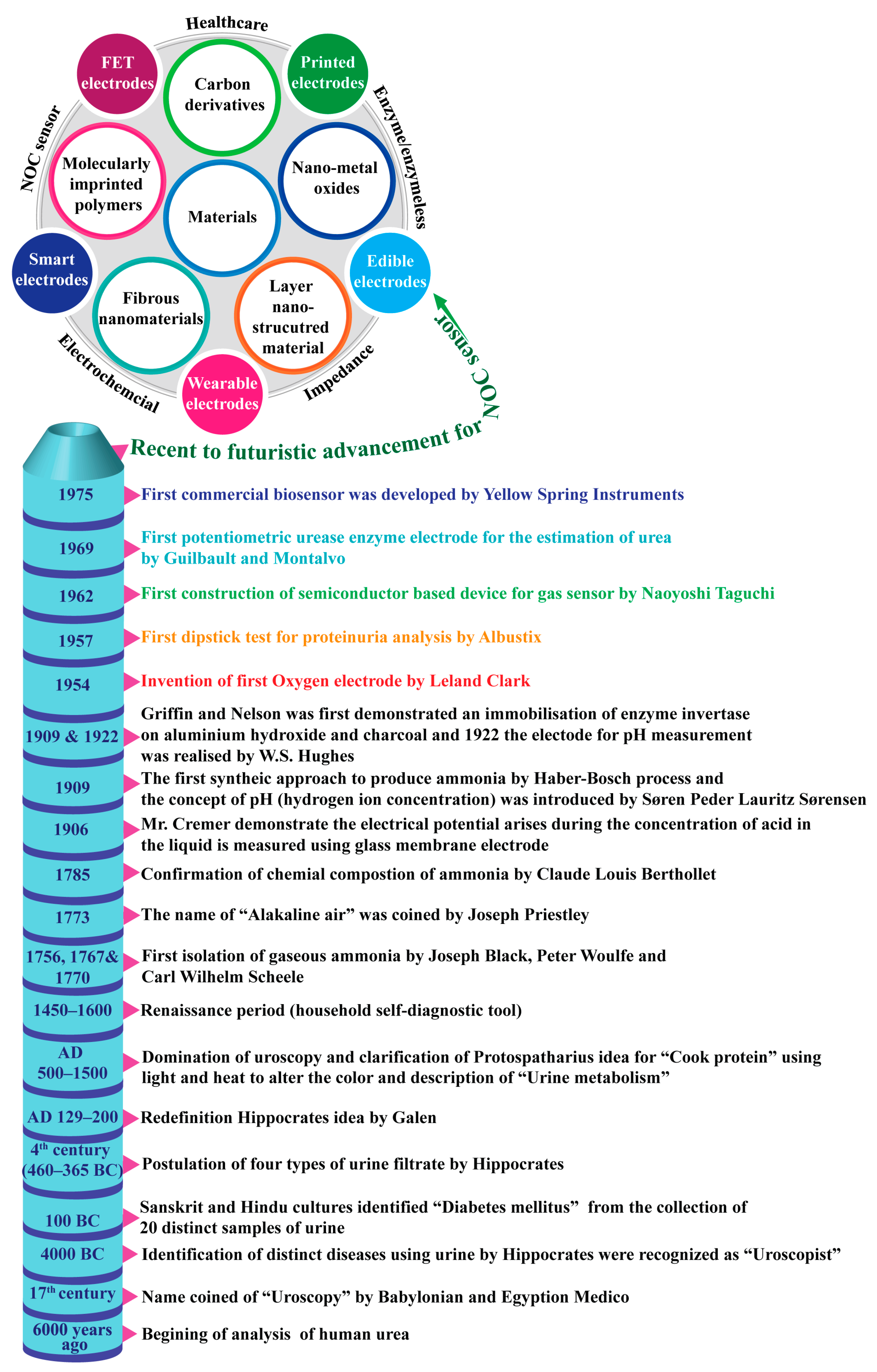
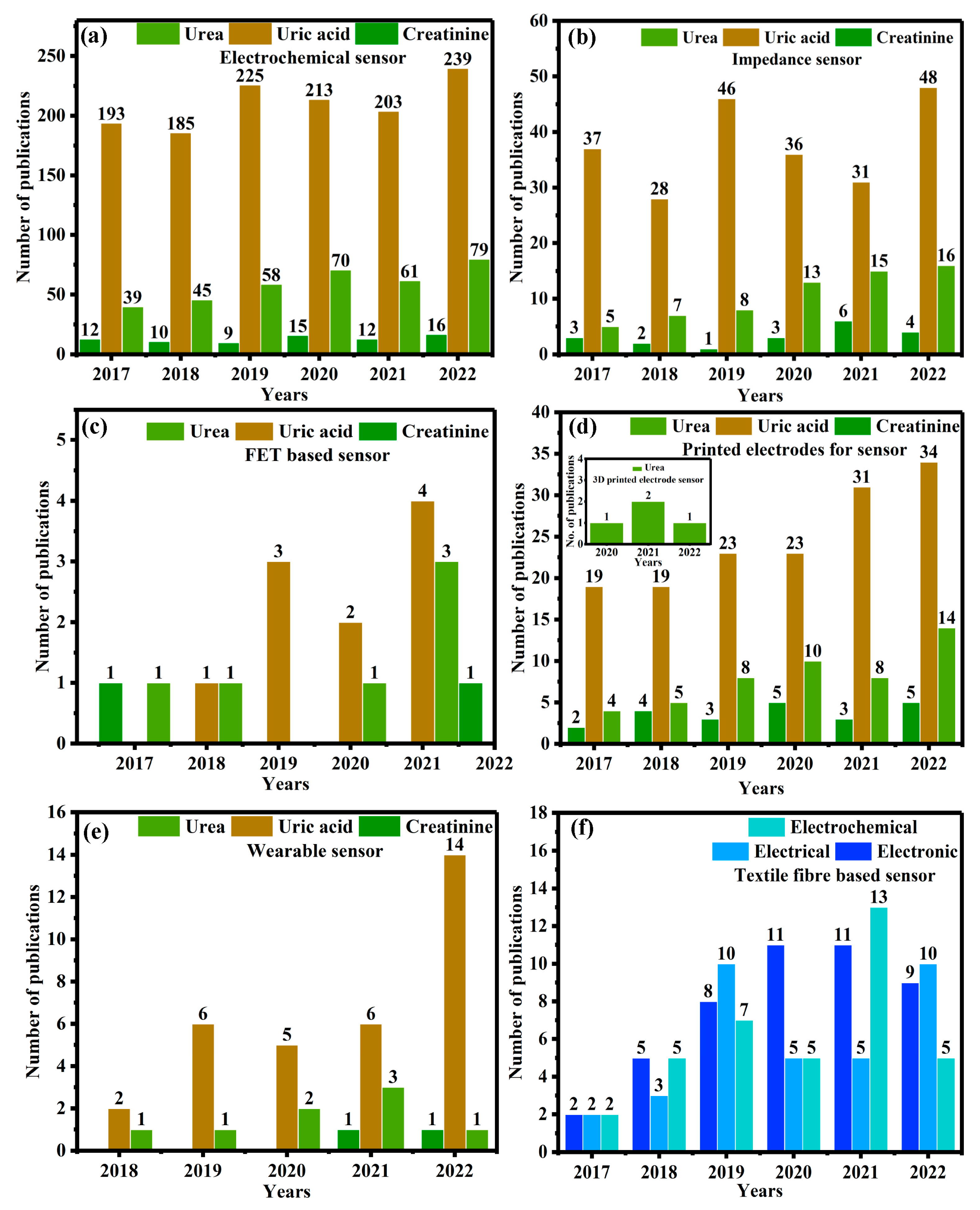

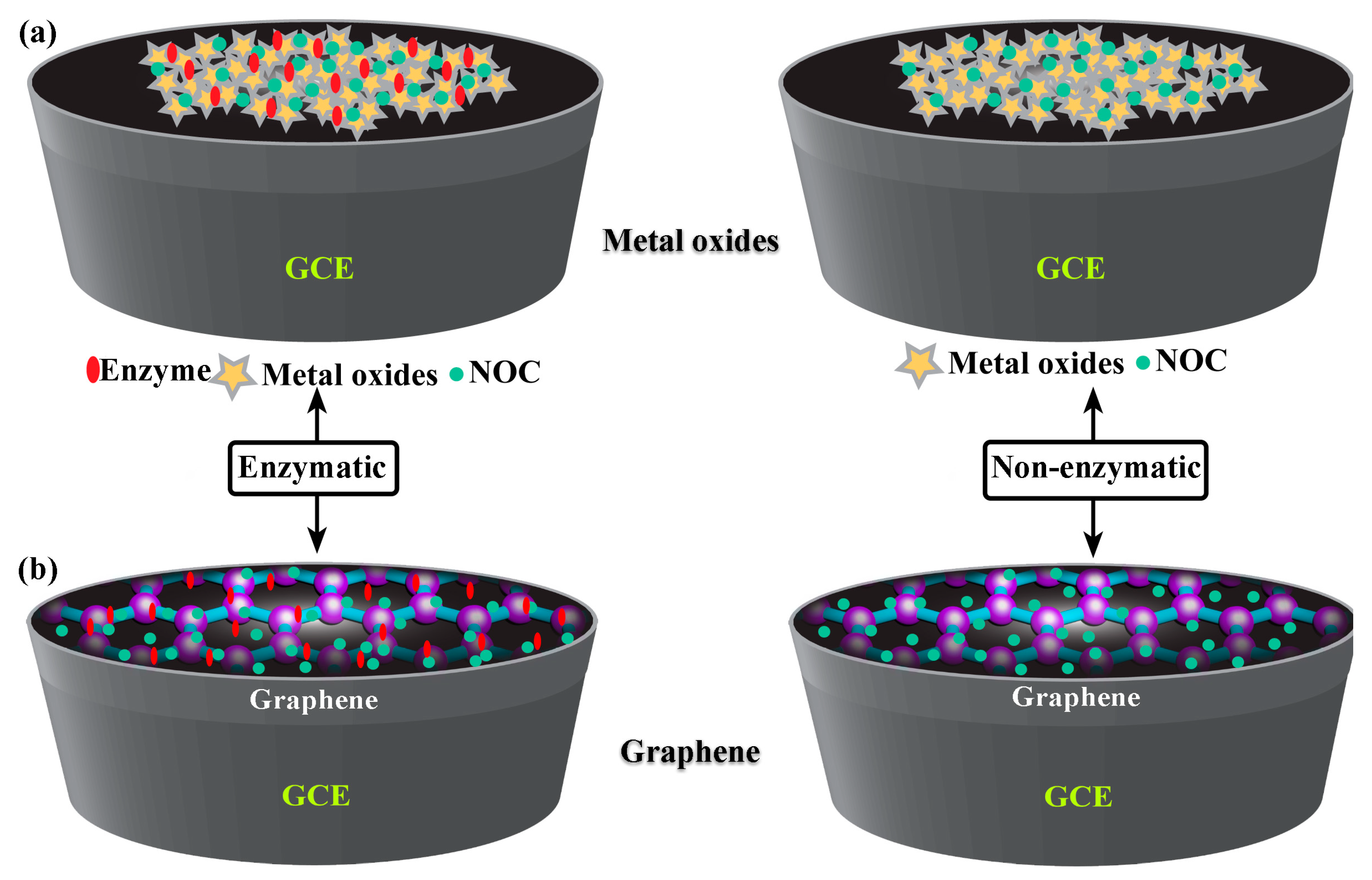

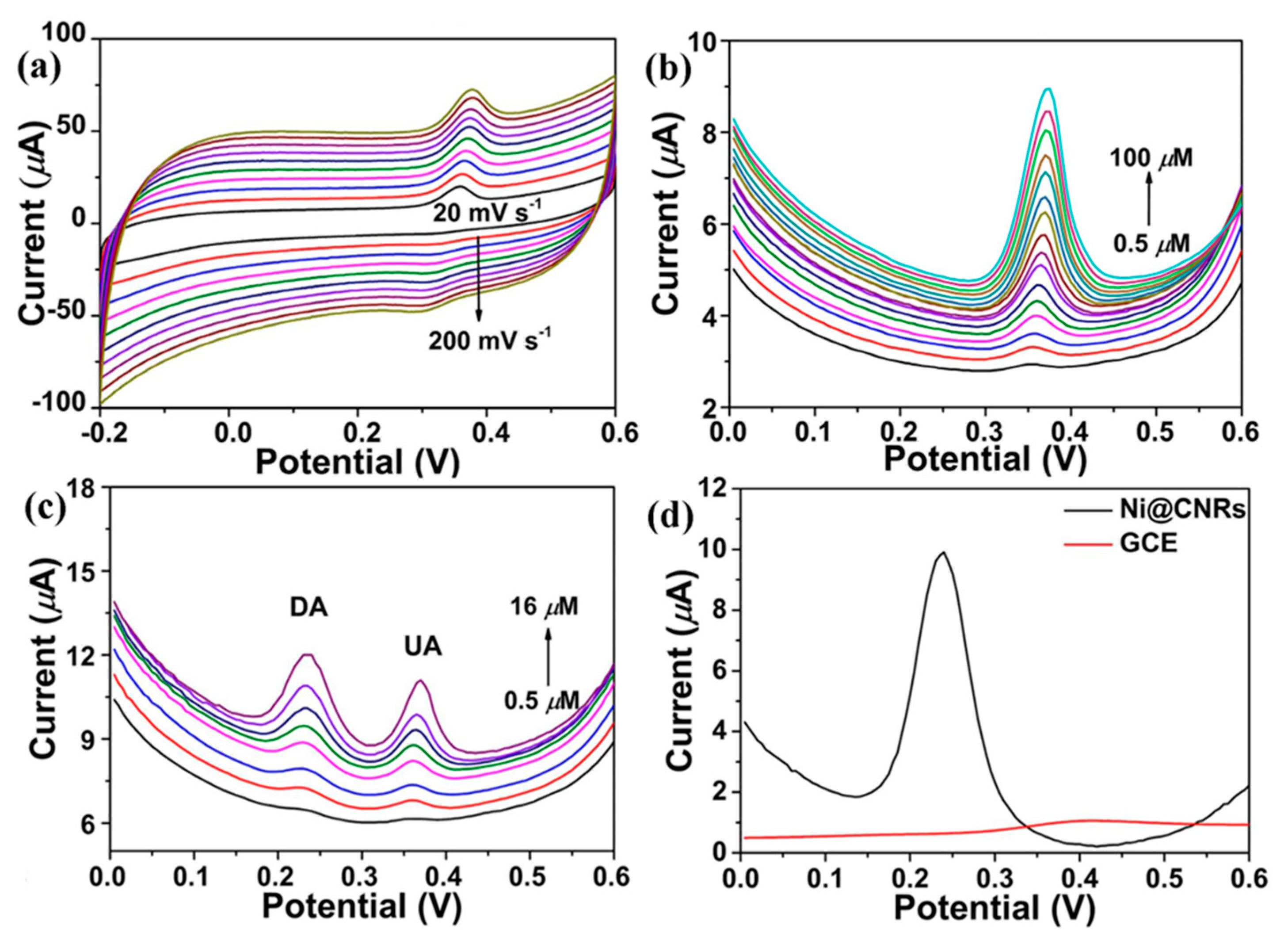
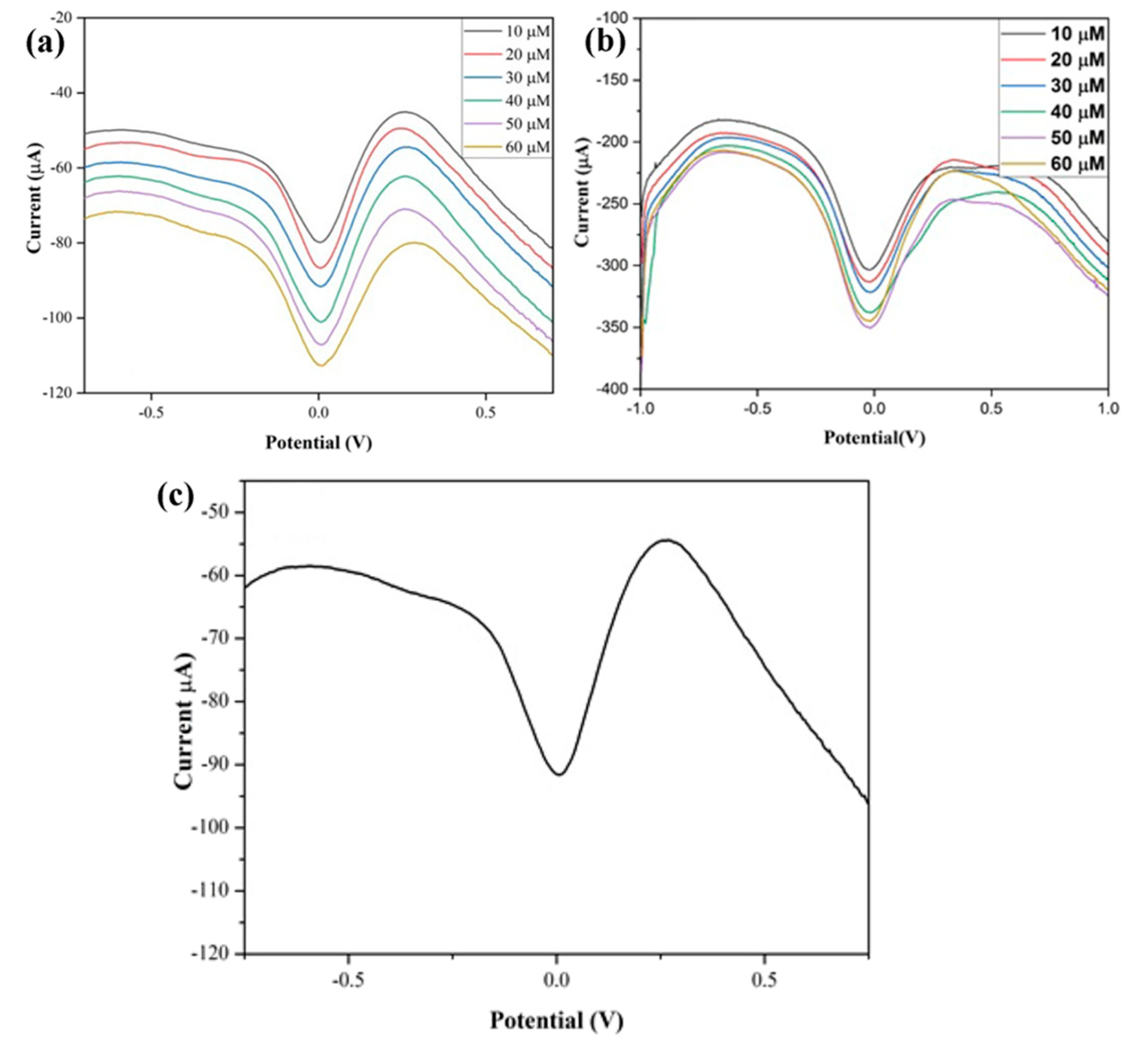
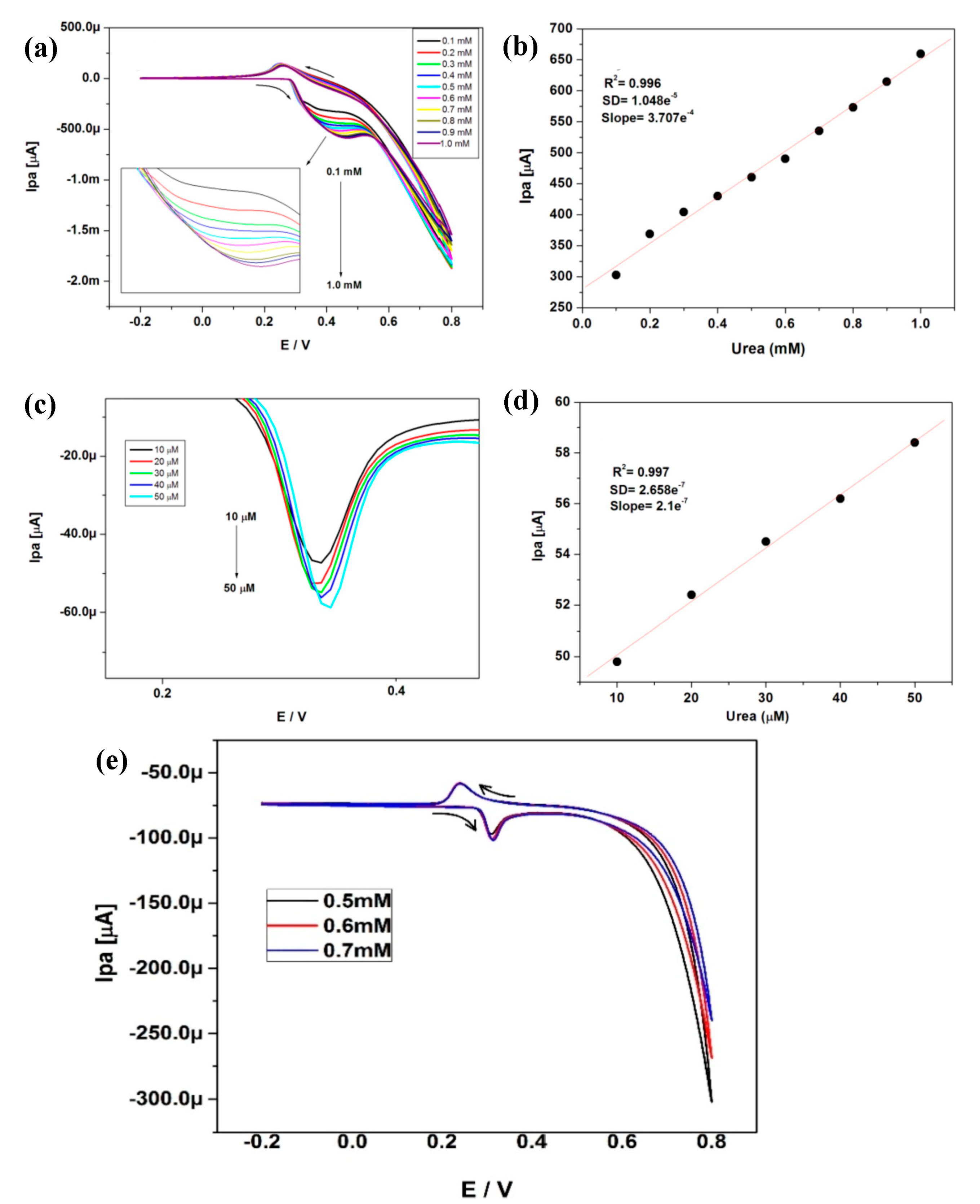
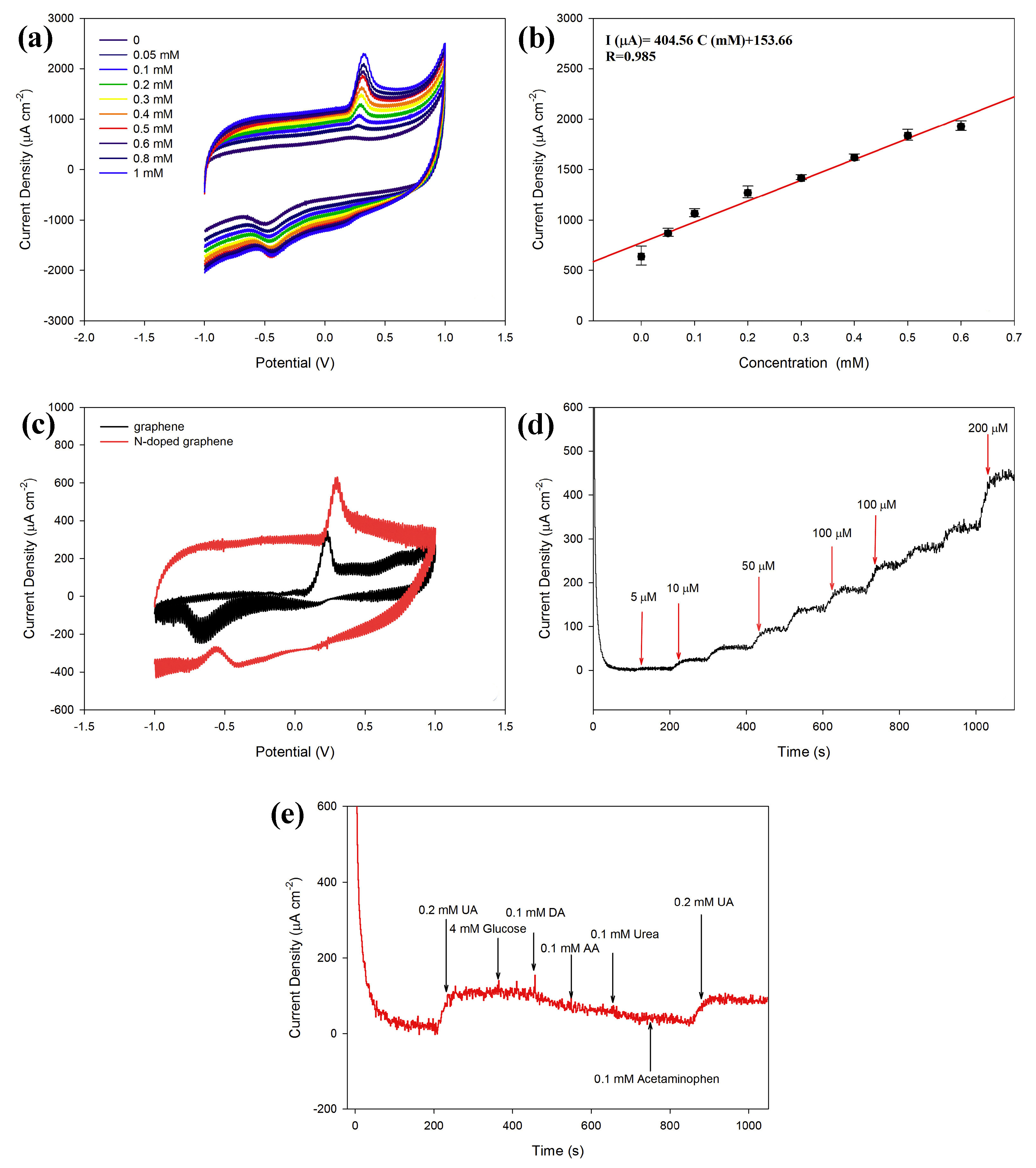

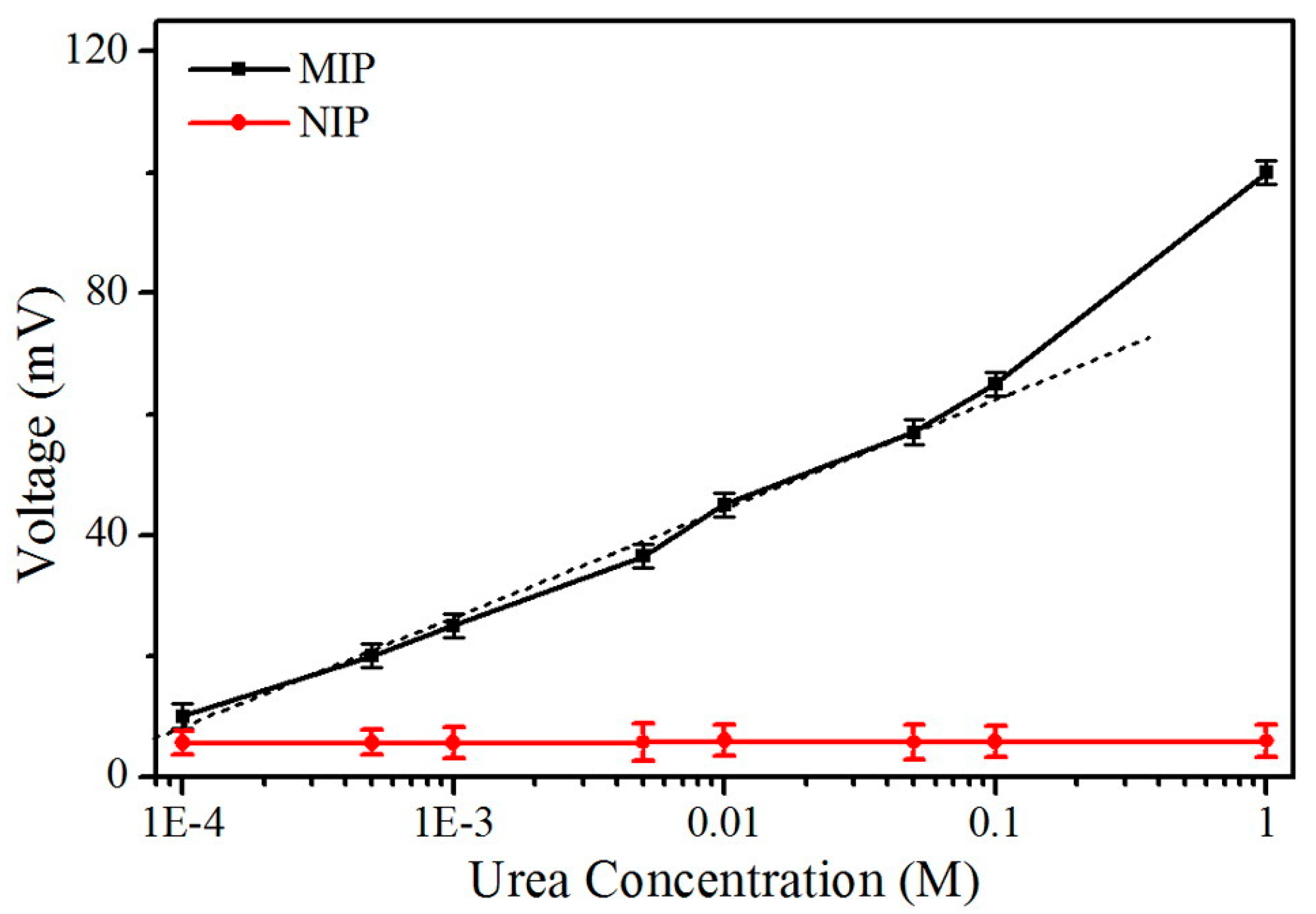
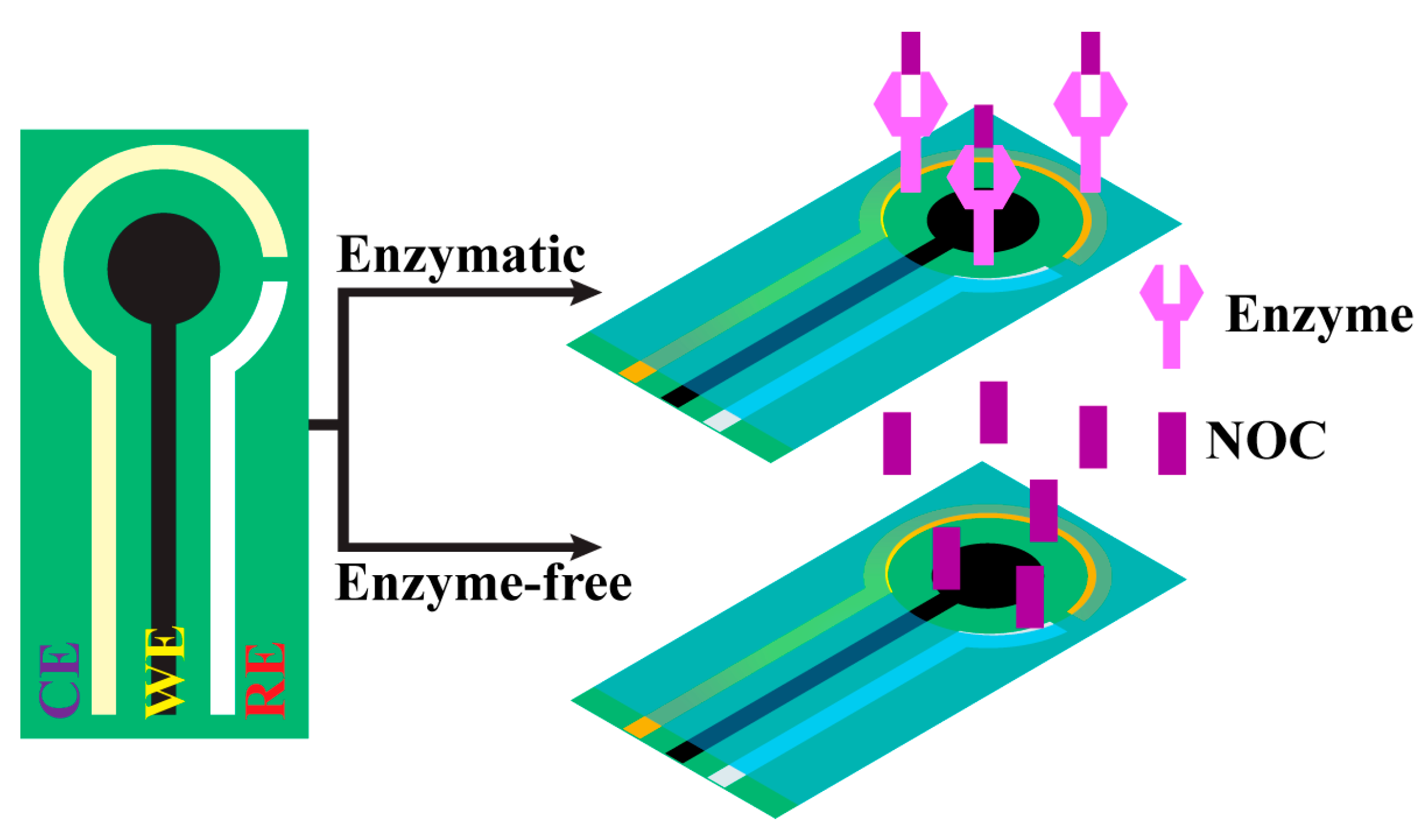

| S. No. | NOC | Age (Years) | Normal Level (Male) (mg dL−1) | Age (Years) | Normal Level (Female) (mg dL−1) |
|---|---|---|---|---|---|
| 1 | Urea | 1–17 | 7–20 | 1–17 | 7–20 |
| >18 | 8–24 | >18 | 6–21 | ||
| 2 | Uric Acid | 1–10 | 2.4–5.4 | 1 | 2.1–4.9 |
| 11 | 2.7–5.9 | 2 | 2.1–5.0 | ||
| 12 | 3.1–6.4 | 3 | 2.2–5.1 | ||
| 13 | 3.4–6.9 | 4 | 2.3–5.2 | ||
| 14 | 2.7–7.4 | 5 | 2.3–5.3 | ||
| 15 | 4.0–7.8 | 6 | 2.3–5.4 | ||
| >16 | 3.7–8.0 | 7–8 | 2.3–55 | ||
| 9–10 | 2.3–5.7 | ||||
| 11 | 2.3–5.8 | ||||
| 12 | 2.3–5.9 | ||||
| >13 | 2.7–6.1 |
| S. No. | NOC | Age (Years) | Normal Level (Male) | Age (Years) | Normal Level (Female) |
|---|---|---|---|---|---|
| 1 | Serum creatinine | 19–75 | 0.74–1.35 mg dL−1 | 19–75 | 0.59–1.04 mg dL−1 |
| Typical range based on BSA * | 19–75 | 77–160 mL/min/BSA | 18–29 | 78–161 mL/min/BSA | |
| 30–39 | 72–154 mL/min/BSA | ||||
| 40–49 | 67–146 mL/min/BSA | ||||
| 50–59 | 62–139 mL/min/BSA | ||||
| 60–72 | 56–131 mL/min/BSA | ||||
| 2 | Albumin/creatinine ratio # | 19–75 | <17 mg/g | 19–75 | <25 mg/g |
| S. No | Electrode Type | Analytical Technique | Enzyme Immobilization Method | Linear Range | Limit of Detection | Real Samples | Ref. |
|---|---|---|---|---|---|---|---|
| 1. | Ni-P | Amperometric | Enzyme free | 0.05–11 mM | 12 µM | Swimming pool water | [50] |
| 2. | Co-ZIF-NiMWs | DPV | Enzyme free | 0.0005–0.5 mM | 0.30 µM | Human urine and milk | [52] |
| 3. | NiO/cESM/GCE | SWV | Enzyme free | 0.05–2.5 mM | ∼20 µM | Tap water | [53] |
| 4. | NiCo2O4 NWs/GCE | CV | Enzyme free | 0.01–5 mM | 1.0 µM | - | [55] |
| 5. | Ni(OH)2/GCE | CV and DPV | 25–90 µM | 1.701 µM | - | [56] | |
| 6. | Ur/NiO/ITO/glass | CV | Enzymatic | 0.83–16.65 mM | 0.28 mM | - | [57] |
| 7. | NiO/cellulose/CNT | Chronoamperometric | Non-enzymatic | 0.01–1.4 mM | 7 µM | Urine | [42] |
| 8. | Vitamin C based NiO/GCE | Amperometry | Non-enzymatic | 100–1100 μM | 10 μM | Mineral, river, and tap water | [58] |
| 9. | NiO/CTAB/GO/GCE | Amperometry | Non-enzymatic | 100 –1200 µM | 8 µM | Mineral, river, and tap water | [59] |
| 10. | Ni/Au electrode | CV | Non-enzymatic | - | 3.35 × 10−2 mM | Urine | [60] |
| S. No | Electrode Type | Analytical Technique | Enzyme Immobilization Method | Linear Range | Limit of Detection | Real Samples | Ref. |
|---|---|---|---|---|---|---|---|
| 1. | Gr-PANi/GCE | I–V | Non-enzymatic | 10–200 μM | 5.88 μM | Milk and tap water | [23] |
| 2. | Ni@CNRs | DPV | Enzyme free | 35–100 μM | 0.166 μM | Human urine | [65] |
| 3. | Ni/RGO/CCF | DPV | Enzyme free | 10–60 μM | 5.083 μM | Human sweat | [66] |
| 4. | NiS/GO/MGCE | CV | Enzyme free | 0.1–1.0 mM | 3.79 μM | Milk | [67] |
| 5. | Ni(OH)2/Mn3O4/rGO/PANi | CV | Enzyme free | 30 μM–3.3 mM | 16.3 μM | Human serum | [68] |
| 6. | 2D NiO papers | i-t | Enzyme free | 4.4–181.6 mM | 2 μM | - | [69] |
| 7. | CoxNi1−x(OH)2/G/GCE | DPV | Enzyme free | 0.25–925 μM | 0.097 μM | Urine | [70] |
| 8. | ITO/PDPA/PTA/Gra-ME nanohybrid | CV | Enzyme free | 1–13 μM | - | - | [71] |
| 9. | NG | CV | Enzyme free | 0–600 μM | 0.0045 μM | Serum | [72] |
| 10. | GND/PANI/urease | I–V | Enzymatic | 0.1–0.9 mg mL−1 | 0.05 mg mL−1 | - | [73] |
| 11. | Graphene nanoplatelet/graphitized nanodiamonds nanocomposite | I–V | Enzymatic | 0.1–0.9 mg mL−1 | 5 μg/mL | - | [74] |
| 12. | NiCo2O4/3D graphene/ITO | Chronoamperometric | Non-enzymatic | 0.06–0.30 mM | 5.0 µM | Urine | [75] |
| 13. | NiS/GO/MGCE | CV | Non-enzymatic | 0.1–1.0 mM | 3.79 µM | Milk | [67] |
| S. No | Electrode Type | Enzyme Immobilization Method | Linear Range | Limit of Detection | Analytical Technique | Real Samples | Ref. |
|---|---|---|---|---|---|---|---|
| 1. | MWCNT/PoT/SPE | Enzymatic | 0.1–11 mM | 0.03 mM | CV | Human blood | [88] |
| 2. | PEDOT/C-Au NTs EC | Non-enzymatic | 1−100 mM | - | DPV | human sweat | [89] |
| 3. | Urease/MBs/GO/NiO | Enzymatic | 1.665–8.325 mM | 0.223 mM | V-T | - | [90] |
| 4. | OECTs | Enzymatic | 1 μM–10 mM | 1 μM | I-V | - | [91] |
| 5. | MWCNT/PANi-modified SPCE | Non-enzymatic | 10–50 µM | 10 µM | CV | - | [92] |
Disclaimer/Publisher’s Note: The statements, opinions and data contained in all publications are solely those of the individual author(s) and contributor(s) and not of MDPI and/or the editor(s). MDPI and/or the editor(s) disclaim responsibility for any injury to people or property resulting from any ideas, methods, instructions or products referred to in the content. |
© 2023 by the authors. Licensee MDPI, Basel, Switzerland. This article is an open access article distributed under the terms and conditions of the Creative Commons Attribution (CC BY) license (https://creativecommons.org/licenses/by/4.0/).
Share and Cite
Jagannathan, M.; Dhinasekaran, D.; Rajendran, A.R.; Cho, S. A Review of Electroactive Nanomaterials in the Detection of Nitrogen-Containing Organic Compounds and Future Applications. Biosensors 2023, 13, 989. https://doi.org/10.3390/bios13110989
Jagannathan M, Dhinasekaran D, Rajendran AR, Cho S. A Review of Electroactive Nanomaterials in the Detection of Nitrogen-Containing Organic Compounds and Future Applications. Biosensors. 2023; 13(11):989. https://doi.org/10.3390/bios13110989
Chicago/Turabian StyleJagannathan, Mohanraj, Durgalakshmi Dhinasekaran, Ajay Rakkesh Rajendran, and Sungbo Cho. 2023. "A Review of Electroactive Nanomaterials in the Detection of Nitrogen-Containing Organic Compounds and Future Applications" Biosensors 13, no. 11: 989. https://doi.org/10.3390/bios13110989
APA StyleJagannathan, M., Dhinasekaran, D., Rajendran, A. R., & Cho, S. (2023). A Review of Electroactive Nanomaterials in the Detection of Nitrogen-Containing Organic Compounds and Future Applications. Biosensors, 13(11), 989. https://doi.org/10.3390/bios13110989






